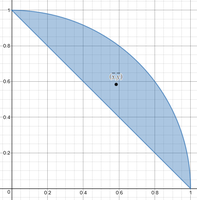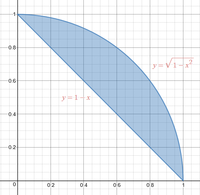Using simple geometry, we know this area will be:
[MATH]A=\frac{1}{4}(\pi-2)=\frac{\pi}{4}-\frac{1}{2}[/MATH]
Let's integrate:
[MATH]A=\int_0^1\sqrt{1-x^2}-(1-x)\,dx=\int_0^1\sqrt{1-x^2}+x-1\,dx[/MATH]
Now, consider:
[MATH]A_1=\int_0^1 \sqrt{1-x^2}\,dx[/MATH]
Let:
[MATH]x=\sin(\theta)\implies dx=\cos(\theta)\,d\theta[/MATH]
And we obtain:
[MATH]A_1=\int_0^{\frac{\pi}{2}} cos^2(\theta)\,d\theta[/MATH]
Utilize a double-angle identity for cosine:
[MATH]A_1=\frac{1}{2}\int_0^{\frac{\pi}{2}} cos(2\theta)+1\,d\theta=\frac{1}{4}\left[\sin(2\theta)+2x\right]_0^{\frac{\pi}{2}}=\frac{\pi}{4}[/MATH]
Next, consider:
[MATH]A_2=\int_0^1 x-1\,dx=\frac{1}{2}\left[x^2-2x\right]_0^1=-\frac{1}{2}[/MATH]
Hence:
[MATH]A=A_1+A_2=\frac{\pi}{4}-\frac{1}{2}\quad\checkmark[/MATH]
Next, we want to compute the moment of the system about the \(y\)-axis:
[MATH]M_y=\int_0^1 x\left(\sqrt{1-x^2}+x-1\right)\,dx[/MATH]
Consider:
[MATH]M_{y_1}=\int_0^1 x\sqrt{1-x^2}\,dx[/MATH]
Let:
[MATH]u=1-x^2\implies du=-2x\,dx[/MATH]
And we have:
[MATH]M_{y_1}=\frac{1}{2}\int_0^1 \sqrt{u}\,du=\frac{1}{3}[/MATH]
And next:
[MATH]M_{y_2}=\int_0^1 x^2-x\,dx=\frac{1}{6}\left[2x^3-3x^2\right]_0^1=-\frac{1}{6}[/MATH]
Hence:
[MATH]M_y=\frac{1}{3}-\frac{1}{6}=\frac{1}{6}[/MATH]
Next, we want to compute the moment of the system about the \(x\)-axis:
[MATH]M_x=\frac{1}{2}\int_0^1\left(\sqrt{1-x^2}\right)^2-\left(1-x\right)^2\,dx=\frac{1}{6}[/MATH]
And so we find:
[MATH]\overline{x}=\overline{y}=\frac{M_y}{A}=\frac{\dfrac{1}{6}}{\dfrac{\pi}{4}-\dfrac{1}{2}}=\frac{2}{3\pi-6}[/MATH]
Here's a diagram with the centroid plotted:



